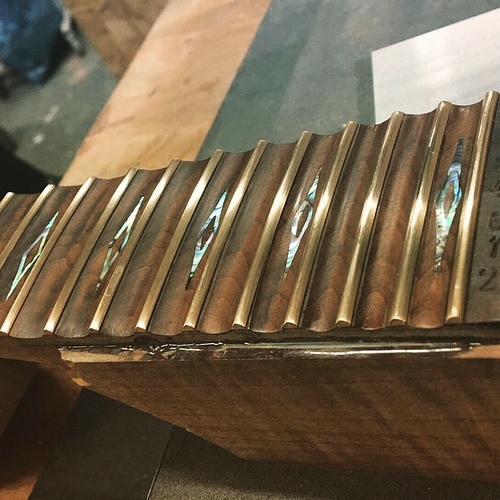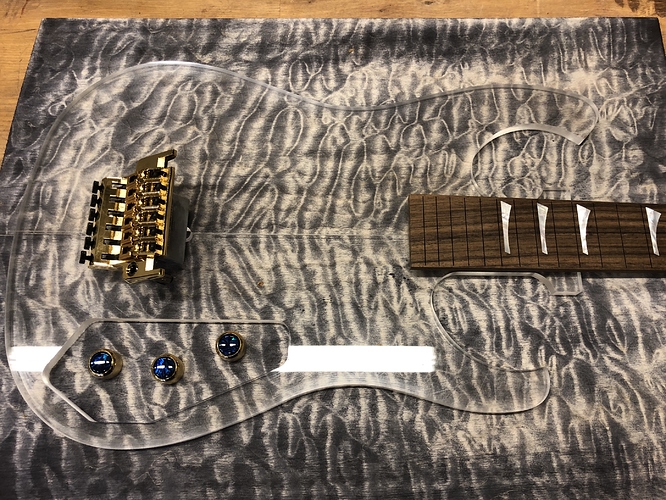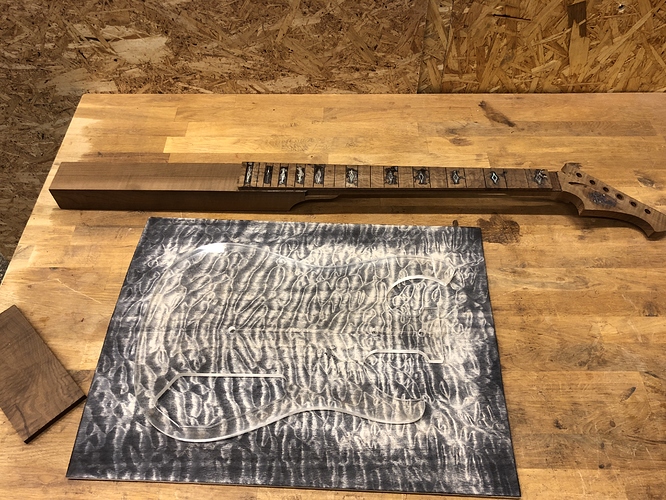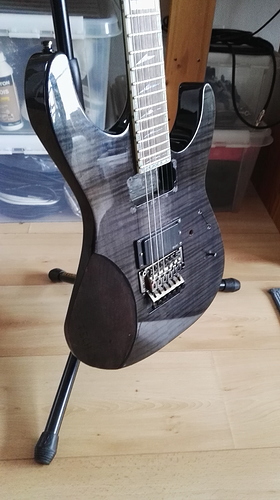Gratuitous shout out to my rep, Matt Emick a.k.a. Batman.  \m/
\m/
sweet looking Kramer. and it sounds good too!
I can’t speak for Kiesel (I’ve only played Carvins, which barring a few notable exceptions haven’t really impressed me), but my main guitar is a Suhr Modern 7 string, and prior to that I’d been a long-time Ibanez player. I’ve played a couple jaw-droppingly good Ibanez guitars over the years, and a whole bunch anywhere from “good” to “toneless planks.” I have yet to play a bad Suhr. I wasn’t aware they’d gotten trendy with the djent scene in the same way Kiesel has, and if that’s the case I’m sorry to hear it… But, Suhr makes VERY nice instruments. They’re also not all that extravagantly expensive, even compared to an Ibanez, unless you go down the fancy top rabbit hole.
Thanks @uglijimus 

@Drew Yeah, I don’t even remember what I said about Suhr. I can’t afford any of those guitars right now. The prices are ridiculous. I’m sure the Suhrs are great guitars man.
Eh, a base Suhr can be had new for about $2k. For what they are, that’s pretty reasonable.
Then again, the guitar I’ll take to the grave is still my American Strat I bought new back in '98 for less than half of that, and some of the guitars I’ve unexpectedly liked the most over the years I’d picked up used for only a couple hundred (including an '04 or '05 Ibanez RG1527 which had one of the best necks I’ve ever played), so it’s not like you NEED to spend that kind of money to buy a killer guitar.
I would say my moss green headless Holdsworth Carvin (now sold by Kiesel), but I’m finding that I really wish it had a cutaway under my forearm.
I like Sweetwater but I really hate the stalky phone calls for weeks because I bought some picks or strings.
Eh, get to know your rep. Mine used to call me occasionally to follow up after purchases, which depending on how you look on it is actually way over and above for customer service or a little creepy, but I gradually switched it to email (there were a few times where he called during working hours where I either didn’t want to, or literally couldn’t take the call, so I just shot him an email afterwards to apologize for missing the call and say thanks), and then have occasionally sent him an email with a question about something I was looking at. He figured out email is usually the easier way to communicate with me, so we’ve mostly stuck to that since then. Decent guy, he’s been pretty helpful on a couple occasions in the past, and they put candy in their shipping boxes - they’re easily my favorite of the “big” music shops to deal with.
Yeah, “creepy” is not how I would describe my rep. And the company is pretty up front about the personal business approach. I concur on getting to know one’s rep, and I suggest stating your preference not to be cold called/contacted.
Yeah, I think they’re awesome, personally.
7 years after starting playing I switched to flying V (Randy Rhoads style) because I loved a particular signature model. It was perfect for my natural forearm rotation DWPS, but I never developed other motions (as UWPS with wrist deviation).
Superstrats always felt wrong to me, especially on the shoulder from the picking hand. I am 1,84 m (6 feet) and kind of slim and I think there is a link there.
However, learning more about CTC I knew I had to work on those newer movements, so I switched back to the superstrat shape and decided to sand a forearm bevel into my guitar.
With this bevel for the picking arm, guitar feels insanely good again. I’ve done it on many guitars since.
The next guitar is the perfect one 
Hear, hear. For playing when standing I’ve come to see the bevel as critical. Cool that you’ve been able to get it done on several instruments.
Here is my story about playing on the best guitar in my life:
I had bought a few things from Murch Music in Cambridge an hour outside of Toronto and took a friend to try out a Clarus. When the deal was done Glen Murch brought a guitar out and handed it to me and we jammed on Joy Spring unplugged. I know nothing about guitars but this one felt nice and sounded great. He packed it back in its case and I stupidly joked “if we but the two amplifiers will you throw in the guitar?” He replied, “in all seriousness if you buy the guitar I’ll throw in the two amps”. How much say I. $35,000 US say he. I was glad it was back in the case and I didn’t know that before playing it. You will think I’m an idiot and you may be right but it was one of those New York made guitars with an Italian name starting with ‘D’.
Glen showed me a manifest of who had owned this guitar and among the names were Joe Pass and George Benson. What astounds me is Glen didn’t know me at all, we’d done a little business but he had no problem letting me try it. Needless to say we bought the amps and left.
Murch Music is now a branch of the amazing Long & McQuade chain and if you are in the region be sure to stop in.
I really really wanted a specific kind of Bass VI and it drove me insane to the point that I just ended figuring out how to build what I wanted. Took me forever but I did what @Drew mentions in his reply: Got the parts from Warmoth and figured out the electronics then built it. My first one sucked, but like…10 revisions later I have exactly what I want:
That’s an older picture as I’ve changed out the pickups to Bare Knuckle Pickups which are much more insane and better than those Strat style rails. The big differences in this Bass VI from other ones are:
- Hard tail. The tremolo on most BVI guitars is a terrible Jazzmaster thing that doesn’t work for a 30" scale guitar.
- eCam style bridge so I can intonate it easier and better.
- Much lighter gauge strings, going 13-68 I think, or something around there. That makes it sound a lot less like a bass and more like a cello, which works a lot better.
- No finish on the neck. It’s made of Wenge so it is a dense hard hard hard wood that doesn’t need finish. I like the rough texture and feel.
- Gigantic frets using the gold wire rather than stainless. The gold wire is an alloy that’s almost as strong as the stainless, but otherwise it’s just for looks. The gigantic frets make it way easier to play at the larger scale.
- Passive hum-bucking pickups that have the feel of active pickups.
- A single coil middle pickup that’s hot as the sun.
- A super switch that combines the pickups into about 8 different combos (with an extra switch) so I can get hum canceling for almost every position, plus some series/parallel configurations.
- A blend knob to bring in the middle pickup in any position, which helps add treble where I need. That’s important on this guitar because it’s 1 octave lower, but it can be EQed to sound like it’s in the same octave but just heavier. Blending in some single coil middle helps get that effect.
- An active peamp from Audere. This would normally be in a regular 4 string bass, but the Audere is configurable, so I was able to get it to hit all the frequency ranges for the Bass VI. I also chose the Audere because it doesn’t change the original sound of the passive pickups. It just boosts what I want.
- An anarchy symbol for the neck plate because…why not?
If you wanted to build your dream guitar I’d say it’s not too hard, but it took me a lot of research and trial and error to get what I wanted finally. If you’re interested in building one then PM me and I’ll point you at the books and stuff to get you going. I love helping people blow money on guitars. 
1979 Ibanez st50
Most people wouldn’t give it a second look but everything about it fit me perfectly.
I have had les paul etc but still nothing felt that good. I may pick one up soon because they aren’t all that spendy.
For me, it’s a Jackson Custom Shop Soloist SL2H-V, the Music Zoo “vintage” edition Soloist, with the top-mount Floyd, Rhoads “Concorde” headstock, smaller control cavity, and EVH low friction volume/high friction tone pots.
My mods:
Better brass knobs
Brass switch tip & knurled switch nut
Brass Floyd block
Buffed the black off the fine tuners to round out the brass look
Swapped the JB bridge for a BKP Holy Diver
I bought it used. The frets had already been ground and polished once, and after owning for 2 years, needed it again, so I had it refretted with big 58x118 stainless wire, and it’s absolutely perfect now.
I checked out Solar Guitars based on recommendations from several people here last summer, and I went with the A2.6C. In the end all I wanted was a guitar where the knobs weren’t in the way of my picking hand. It’s a mid-range guitar costing around 700-800 and my only gripe is the paint job is cheap. I might consider upgrading to their high-end model in another year or so.






